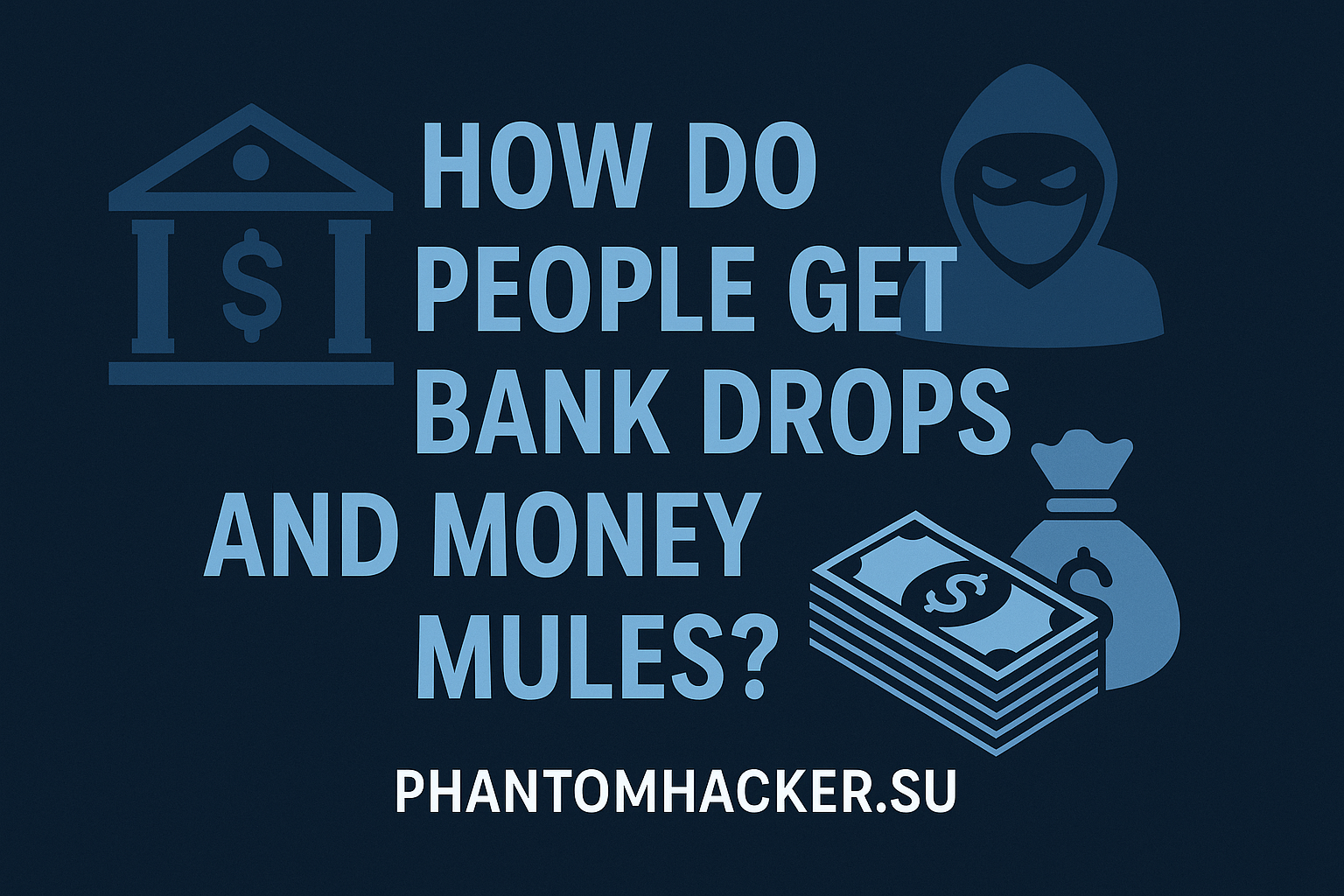I don’t sell dreams. I expose systems.
So let’s clear the air before we dive in—I’m not here to recruit you. I’m not slinging Telegram handles or peddling access to some fake “enterprise.” I’m giving you the playbook the streets and the forums whisper about, but nobody will teach you unless you’re already knee-deep in it. You wanted to know how money mules and bank drops are actually acquired? Buckle in. This isn’t theory. This is gospel from the underbelly.
🧠 What Is a Money Mule (Really)?
A money mule is a puppet on strings. A disposable tool in a high-stakes chess game. They’re the middleman who takes the fall while the real operator fades into digital dust.
A money mule receives dirty money—carded funds, stolen payroll deposits, unemployment benefits, crypto conversions—and moves it. That’s it. They might withdraw it, send it to another account, convert it into BTC, or ship it in envelopes. Most don’t even know they’re laundering funds. Others? They know exactly what they signed up for. Desperation breeds compliance.
Bank drops, on the other hand, are controlled accounts set up to receive those funds—burners, usually. Either real people recruited with stolen data (a.k.a. synthetic IDs) or fullz with a pulse.
🕳️ Where Do These Mules Come From?
Let’s get something straight: there is no Amazon for mules. There’s no well-lit website that pairs carders with ready-to-go runners. That’s fantasy. Most of this game still happens the old way—grimy, manual, and dangerously human.
1. The Street Method
Your average crackhead doesn’t care if the account he just opened is going to be used to funnel $12,000 from a hacked payroll server. As long as you hand him $300 and a pack of smokes, he’s yours. Immigrants, the homeless, addicts—these people are often used like tissue paper in this world. Cold, but real.
You walk up, drop a convincing pitch:
“We need someone to help move some digital marketing funds. We’ll send you $5K, you keep $1K and forward the rest. Want in?”
They nod. They hand over bank logins. Boom—you’ve got a temporary mule.
This isn’t scalable. It’s risky. But it works when you need warm bodies fast.
2. The Corporate Façade: Fake Job Postings
You ever seen a post that says:
“Remote Work Opportunity! Looking for Transaction Coordinators. Must have bank account, work ethic, and internet access.”
That’s not a job. That’s bait.
Cyber ops use sites like LinkedIn, Indeed, ZipRecruiter, even Craigslist to build shell businesses. They create fake companies with names like “SilverGlobe Logistics” or “CryptoEdge Payments LLC.” Then they recruit the financially illiterate, the desperate, or the just plain curious.
Most mules don’t even know they’re committing fraud until the feds knock. They think they’re doing admin work. They forward funds thinking it’s legit. These types are gold—compliant and clean.
Want to scale? You get someone on Fiverr to crank out a hundred job postings. Build a basic WordPress page with a contact form. Add a cheap LLC from Wyoming. Boom—you’re a fake fintech recruiter.
3. Telegram Groups & Darknet Forums
You want plug-and-play mules? Go where the wolves howl.
Telegram is the de facto black market chatroom. Search hard enough and you’ll find “Mule Connects” and “Drop Dealers” who claim they can link you to verified runners—some even broken down by location:
🇺🇸 USA Mules
🇬🇧 UK Only
🇨🇦 CAD Verified
🇦🇺 AUS + NZ Bank Drops
But here’s the kicker: 90% of these are scams. Fake escrow, fake vouches, fake everything. If you’re not already plugged in with reputation or connections, you’re gonna get milked.
Still, those in the know do real business here—quietly. The trick? You don’t ask for a mule. You prove you’re a mover. Show you’re good for volume. Then you get the invite.
4. Grooming via Social Media
Here’s the new wave: fraudfluencers.
These kids post stacks of cash, Louis bags, crypto wins—and then drop vague captions like:
“DM if you want to eat like this.”
“Turn your account into an ATM.”
They recruit high schoolers and broke college students by promising them fast money. Once inside the DM, they get the pitch: “You get paid to help transfer payments.” Or worse, they trick them into giving up account access entirely in exchange for a cut.
Some never get paid. Some get locked up.
The smart ones? They become repeat mules. Groomed assets. Bought loyalty.
🏦 How Do You Get Bank Drops?
There are two flavors here: synthetic and real.
Synthetic Drops (Identity Fraud)
You buy a fullz—name, SSN, DOB, address, email, phone—and pair it with a burner device and clean IP (usually a SOCKS5 or residential proxy). You open a bank account in their name online. Sometimes you go in-branch with a fake ID. That account is now your drop. It’s fragile, but it works.
Real Drops (Controlled Mules)
This is a human with a real, legitimate account who’s either in on it or being manipulated. Either way, you can push funds through and have them send it via Zelle, ACH, Bitcoin, or withdraw it as cash. These are better for laundering large sums or moving funds in high-trust setups.
⚠️ The Risks: Why You Should Care
Muling ain’t safe. Most mules get picked up not because of what they do—but because they’re stupid about it. They use their home IPs. They answer calls from Chase fraud teams. They walk into branches thinking they’re untouchable.
Meanwhile, the puppet master—the real operator—has already moved the funds three chains down.
This is why OPSEC is life. Burner phones. Tails OS. Secure chats. No contact with the mule once they’re activated. You vanish like smoke.
🔍 Real-World Example: The “Crypto Refund Mule” Ring
In 2023, a ring out of Atlanta used fake Shopify stores to process bogus “refunds” to mules’ debit cards. They recruited people on TikTok with the classic “Get paid for nothing” line. These mules received $4K to $9K per drop, forwarded $7K back via Bitcoin, and kept the rest. The feds cracked it after a couple mules got greedy and did it using their main accounts.
That’s the flaw. The second you let ego into the operation—when people start flashing—that’s when the whole house burns.
🧩 So… Is There a “Mule Marketplace”?
Not like people imagine. There’s no “MuleBay” or “Amazon for drops.”
It’s all reputation. Trust. Word-of-mouth in encrypted channels. The people who’ve been doing this for years don’t post mules. They build them. They raise them from scratch. Some operators run entire networks of sleepers—regular people with bank accounts who don’t even know they’re assets… yet.
So if you’re asking “where do I buy mules?”—you’re already too green.
The real players don’t buy them. They design them.
💡 Closing Thoughts: The Mule Isn’t the Game—You Are
You don’t get rich selling drops. You get rich controlling networks.
You build fake HR firms. You run scripts that mass-create synthetic identities. You automate mule outreach through job platforms and Telegram bots.
This game isn’t about theft—it’s about social engineering. It’s about making people hand you what you could’ve stolen anyway. And if you do it right? You’ll never touch the funds yourself. You’ll just watch it all flow—quiet, invisible, untraceable.
The money mule? They’re the front line.
But the architect? That’s the ghost in the shell.
Now ask yourself—
Are you just another pawn in someone else’s game?
Or are you ready to play like the architect?







